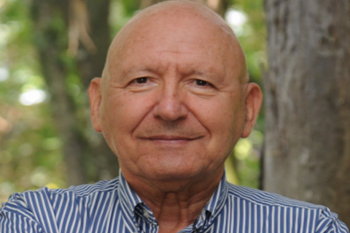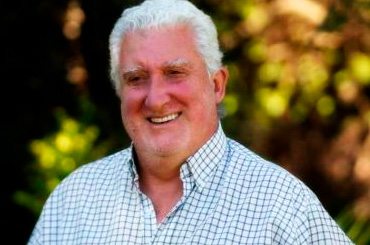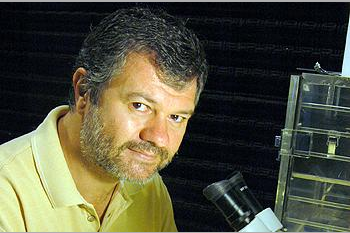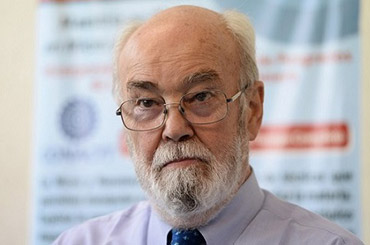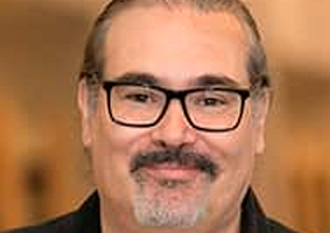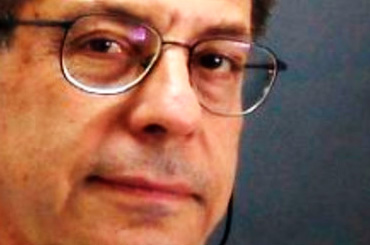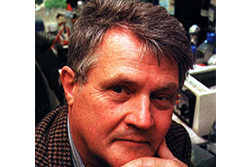Bacharel (1964) e Doutor (1969) em Física (Instituto Balseiro/UNC, Bariloche). Livre-Docente (IFQSC/USP, 1974). Professor do IFQSC/USP (1973-85) e Pesquisador Titular do CBPF (1982-86). Coordenador do Comitê Executivo e Membro do CTC do Projeto Radiação Síncrotron (CNPq, 1983-85). Diretor Adjunto e Chefe do Depto. Científico do LNLS (1987-97). Diretor de Escola bianual (ICTP/Trieste 1991-2008). Professor Titular (1988-2008), Chefe de Depto. (2002-06) e Presidente da Comissão de Pesquisa (2007-08) do IF/USP. Atualmente, Professor Sênior (IF/USP 2009), Bolsista de Produtividade em Pesquisa 1A (CNPq, 1992), Membro da Academia de Ciências do Estado de São Paulo (1980) e Co-Editor do Journal of Synchrotron Radiation/IUCr-UK (2009). Pesquisas sobre propriedades e transições estruturais de nanomateriais. Autor de 205 artigos científicos em revistas indexadas e 10 capítulos de livro. Orientador de 9 teses e 9 dissertações. http://lattes.cnpq.br/5852367984234501
Nacionalidade: Argentina
Jorge Horacio Medina
Possui graduação em Medicina pela Universidad de Buenos Aires(1982). Atualmente é Profesor adjunto da Universidad de Buenos Aires. Tem experiência na área de Medicina, com ênfase em Psiquiatria.
Daniel Mario Ugarte
Físico (Universidad Nacional de Córdoba, Argentina – 1985), doutor em Física (Université Paris XI-1990). Professor titular do Instituto de Física “Gleb Wataghin”-UNICAMP desde 2007. Responsável pela criação do Laboratório Multi-Usuários de Microscopia Eletrônica do LNLS e seu coordenador de 1999 a 2004. Prêmios: Zeferino Vaz (UNICAMP-2011), Scopus (CAPES-ELSEVIER-2008), Guggenheim (2002), Latsis (Genebra-1994). Faz pesquisas em propriedades eletrônicas e estruturais de nanossistemas. Orientou 6 teses de doutorado, das quais 2 ganharam o Prêmio de Melhor Tese da Sociedade Brasileira de Física (2000 e 2003) e 1 o Prêmio Capes de Tese em Astronomia e Física (2011). Publicou mais de 100 artigos de pesquisa em revistas internacionais. Principais contribuições: descoberta das “cebolas de carbono” (Nature, 1992), desenvolvimento do canhão de elétrons baseado em nanotubos de carbono (Science, 1995), medidas das propriedades de transporte eletrônico quântico e propriedades mecânicas de nanofios metálicos por experimentos in-situ de microscopia eletrônica (Phys. Rev. Lett., Nature NANO, Nano Lett, 2000 a 2011). Proferiu mais de 60 conferências convidadas em Congressos internacionais como: American Physical Society, Material Research Society, Internacional Congress Electron Microscopy.
Victor Alberto Ramos
Possui graduação em Geologia pela Universidade de Buenos Aires (1965), mestrado em Photointerpretation for Geology pela International Institute for Aerial Survey and Earth Sciences (1968) e doutorado em Geologia pela Universidade de Buenos Aires (1970) . Atualmente é Professor Titular da Universidade de Buenos Aires.
Enrique Ramiro Pujals
Possui graduação em Licenciatura En Ciencias Matematicas – Universidad de Buenos Aires (1992) e doutorado em Matemática pela Associação Instituto Nacional de Matemática Pura e Aplicada (1996). Atualmente é pesquisador titular da Associação Instituto Nacional de Matemática Pura e Aplicada. Tem experiência na área de Matemática, com ênfase em Sistemas Dinâmicos, atuando principalmente nos seguintes temas: dinamicas robustas e genericas; bifurcacoes homoclinicas; aplicacoes de sistemas dinamicos.Atualmente é Bolsista de Produtividade do CNPq, Foi distinguido com convites para proferir palestras no Congresso Internacional de Matemáticos (2002) e no Congresso Internacional de Física Matemática (2006). Ganhou o Prêmio UMALCA em 2004 , o premio ICTP-Ramanujan em 2008 e o premio em matematica da TWAS em 2009.
Raúl Antonino Feijóo
ossui graduação em Engenharia Civil – Universidad Nacional de Córdoba (1969), mestrado em Engenharia Civil pela COPPE/UFRJ Instituto Alberto Luiz Coimbra de Pós Graduação e Pesquisa de Engenharia (1973) e doutorado em Engenharia Mecânica pela COPPE/UFRJ Instituto Alberto Luiz Coimbra de Pós Graduação e Pesquisa de Engenharia (1975). Atualmente é pesquisador titular do Laboratório Nacional de Computação Científica e Coornador (2008-2015) e vice-coordenador (2016-2021) do INCT-MACC Instituto Nacional de Ciência e Tecnologia em Medicina Assistida por Computação Científica. Cientista do Nosso Estado – Faperj. Bolsista de Produtividade em Pesquisa Nível 1A do CNPq.
Eduardo Enrique Castilla
I was raised in my hometown, Buenos Aires, within an environment of humanities and arts. My father was a newspaper man, and everybody in the familys acquaintances was a writer, a philosopher, or a plastic artist. My whole education, in its three levels, was acquired at public schools, obtaining my Medical Degree at the Buenos Aires University, School of Medicine. What brought me into the area of medicine at the age of 17 was certainly not the scientific aspects of it, but rather its human side, leading me to a profession taking care of persons. The vocation that drove me through medical school aimed at being a country doctor, a general practitioner in the nearby area of the Paraná delta, where my father was born. However, right after graduation I realized I was not fully prepared to act as a health provider in a rural environment. I thus decided to go to the USA for an intensive clinical training in the main medical specialties. That was the crucial road-cross of my professional life. In was in the USA that I discovered quantitative biology, pediatrics, and the incipient field of medical genetics. It was June 1959, and Jerôme Lejeune had described the first chromosome anomaly in man only five months before. The training rural doctor was suddenly displaced by a new pediatrician, and a yet unnamed medical geneticist, who returned o his hometown, five years later. Within the next three years in Buenos Aires I could create the two main undertakings of my life, the ECLAMC: Estudio Colaborativo Latino Americano de Malformaciones Congénitas, and the National Centre of Medical Genetics. Both of them surviving at present, forty years later. However, economic and political turbulences in Argentina during the mid 1970s drove me to leave my country, and I came to Brazil, where, in spite of a no too different political situation, I was able to continue operating the 8 years old ECLAMC program with entire intellectual freedom, and to create different work teams in the USP School of Medicine in Ribeirão Preto, University of Brasilia, and UFRJ. When Argentina returned to democracy I entered the CONICET as researcher, and continue coordinating the ECLAMC from two main centers, one in each country, Argentina and Brazil, an adequate set up for an international, non-institutional program, operating in ten South American countries. A few years later I entered as visiting investigator in the newly created Department of Genetics, in the Fundação Oswaldo Cruz, in Rio de Janeiro, where I am still working until now. In short, I received from Buenos Aires my essence, and my profession; from the USA my introduction and development in the science of genetics; and from Brazil my Latin Americanism in theory and practice. I recognize myself as having the city of Buenos Aires as my valley and Latin America as my nation. Unfortunately, neither one would issue a passport for me.
Armando Jose Antonio Parodi
Professor visitante do Instituto de Microbiologia da Universidade Federal do Rio de Janeiro em 1985.
Cientista visitante, Department of Microbiology, The Wellcome Research Laboratories, Research Triangle Park, N.C., U.S.A., no período 1978/1980.
Pesquisador associado, Department of Microbiology and Immunology, Duke University Medical Center, Durham, N.C., U.S.A. de 1978 a 1980.
Cientista visitante, Bruce Lyons Memorial Research Laboratory, Childrens Hospital of Northern California, Oakland, CA, U.S.A. em 1979.
Professor assistente de Bioquímica, School of Sciences, University of Buenos Aires no período 1976/1978.
Post-Doctoral Fellow, Département de Biologie Moléculaire, Institut Pasteur, Paris de 1972 a 1974.
Instrutor de Bioquímica, School of Sciences, University of Buenos Aires nos períodos 1967/1972, 1975/1976.
Graduate Fellow, National Research Council, Argentina de 1966 a 1967.
Eleanor Roosevelt-International Union Against Cancer Fellow – 1972/1973.
Fellow, John S. Guggenheim Memorial Foundation – 1973/1974.
